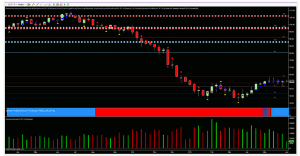Trader Anna Coulling, of AnnaCoulling.com, details how the current price action for oil could best be described as dormant, which—for intra-day oil traders—just means trade what you see on the chart, but for longer-term trend traders, all comes down to a single abbreviation…OPEC.

WTI Oil—Weekly Chart
Click to Enlarge
For longer-term oil traders, it is perhaps the weekly chart which sums up most concisely the current price action for the commodity, which could best be described as dormant, with the WTI contract for July looking set to trade in a narrow range for the fifth consecutive week. What is perhaps most revealing about this longer-term perspective is the general decline in volumes particular in those weeks where the price of oil has risen and in particular the rally of early April onwards, which saw the oil price advance from the $50 per barrel level to reclaim the $60 per barrel region, before entering the current phase of congestion. This period of bullish sentiment was accompanied by falling volume, as buying interest waned. Furthermore, the current weakness was also signaled in the first and second weeks in May with deep wicks to the tops of the candles coupled with above average volume thereby reinforcing this weakness. Since then, the floor and ceiling of support have been built with the support region at $56.50 per barrel tested last week and the ceiling tested in early May at $63.50 per barrel.
Wednesday afternoon sees the weekly release of the oil inventory report from the EIA, with another draw in supply forecast of -1.9m bbls against a previous of – 2.8m bbls, and if duly confirmed, this will be the fifth consecutive week of a draw in inventories, which is in sharp contrast to the extended period of relentless builds week on week of earlier in the year. The question now is why does the price of oil continue to wallow in this trough of congestion? And the answer is simply OPEC. The cartel has set itself on a collision course with the alternative suppliers who it sees as a major threat, and until this threat has been nullified or removed, their policy is very simple. It’s a price war—short and simple—in which the last one standing is the winner. For OPEC, and its member states, this is the only game in town and indeed was confirmed recently when OPEC themselves stated that oil prices would remain below $100 per barrel for the next decade.
For intra-day oil traders, it’s a question of trade what you see on the chart. However, for longer-term trend traders, there is only one game in town at present with OPEC maintaining supply levels high in order to suppress prices further, with the ultimate objective of forcing the alternative energy companies out of business. Cynical perhaps, but given the recent (and unsurprising) revelations in FIFA, as the old saying goes, “All power corrupts, but absolute power corrupts absolutely.”
By Anna Coulling, Professional Trader & Blogger, AnnaCoulling.com





















